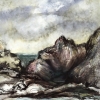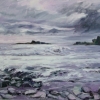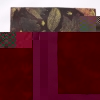Bank Street Gallery

sheila macfarlane
Although she grew up in Fife and went on to study in Edinburgh and Paris, MacFarlane has lived much of her life in the Mearns, perhaps her Aberdonian birth calling her northwards. Is this significant? Undoubtedly. Her diverse oeuvre is steeped in the area’s history, geology, flora, fauna and folklore. Renowned for her “Finella Prints”, she is a passionate, hands-on printmaker. The influence of her time at Atelier 17, in Paris, still scents her creative approach to how she works. She has an uncanny knack of allowing process to lead to product. Finella is a perfect example; a 10th century warrior queen (some would say a witch) who held sway with her husband, the Maermar of the Mearns, from Fettercairn down to The Den of Finella by the sea. The prints reflect MacFarlane’s intense research. She is meticulous in her learning and that approach is matched in her technique. The finest detail is addressed and scale is never an impediment. The huge boards that were the basis of the Finella Prints prepared, they delivered their images, ultimately, by the sheer weight of MacFarlane herself – she literally danced Finella’s image onto fine Japanese paper. One cannot help feeling that the medieval Queen would either have loved or loathed this. Since MacFarlane’s success continues to promote the Finella Legend, one cannot help feeling that the former is the more likely.
Her style is eclectic, not readily pigeonholed. When you are familiar with her work, you can recognise her hand but she is not as immediately identifiable, perhaps, as print-making contemporary, Barbara Robertson. This may be down to her dedication to process. Her approach is often experimental; always open not only to the learning of new techniques but also to the resurrection of historic skills and their evolution for 21st century use. Her feather quill work is phenomenal and she is as happy to talk about its remarkable ease of use, comparing it to the ancient art of the Japanese calligrapher’s brush, as she is about the images she produces with this unusual tool. Her lightness of touch in these images captures the fragile substance of a master watercolourist – her images have an uncanny ability to hold solidity within their frame despite their gossamer qualities. She knows how to compose – and she certainly knows how to produce!
Bank Street Gallery is delighted to be hosting this exhibition which runs until 1st May 2015.



